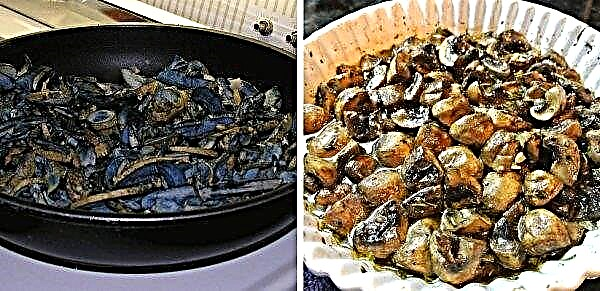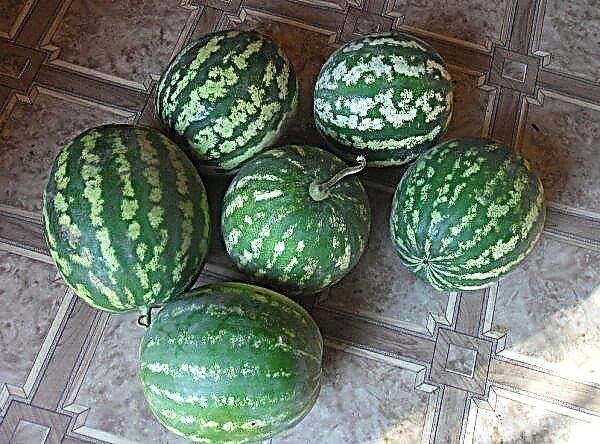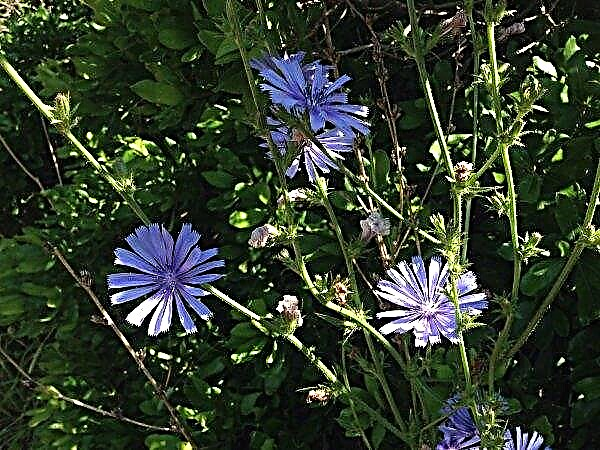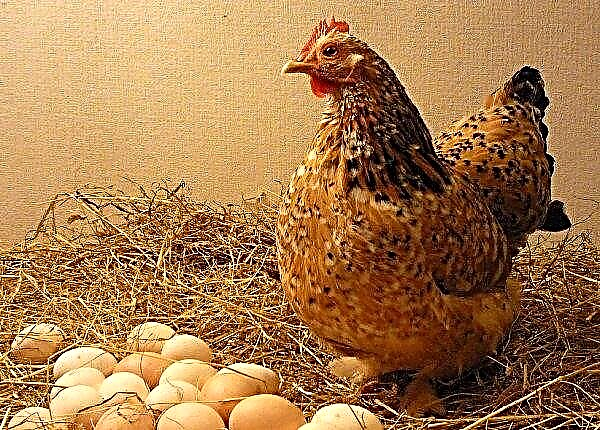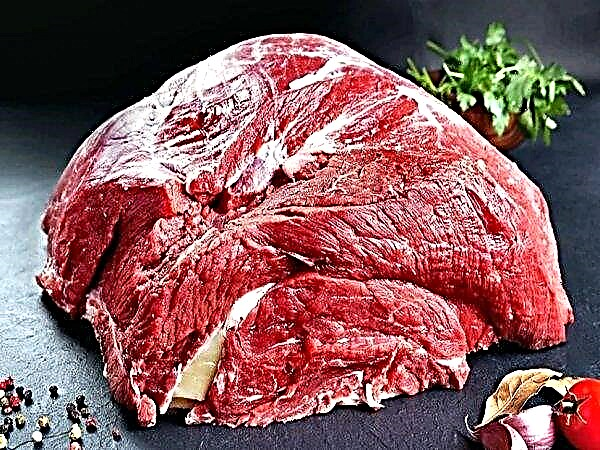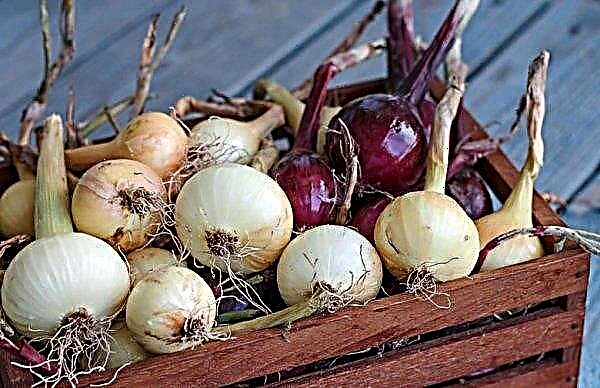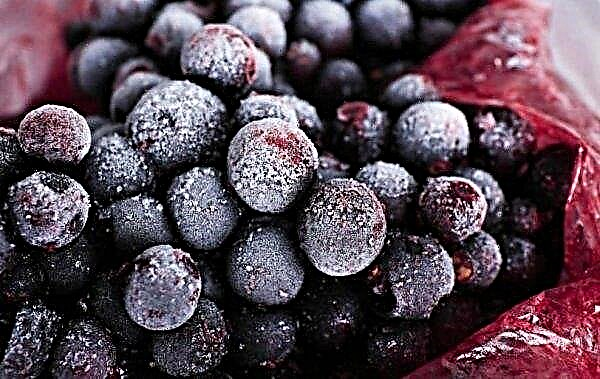Giant is a relatively recent potato variety bred by Russian breeders. It has a high yield, good taste and presentation of tubers. Read more about the Giant variety and its growing technique in this review.
Characterization and description of the variety
The giant was registered in the State Register of the Russian Federation in 2013. The variety is characterized by excellent technical and taste properties and is recommended for cultivation in a temperate climate: Volga-Vyatka district, Central and Central Black Earth.
The variety is distinguished by large tubers weighing from 100 to 140 g. One giant bush will provide you with 8–13 potatoes of approximately the same size. Productivity depends on the quality and fertility of the soil. The maximum recorded crop volume is 913 kg / ha. On average, farms harvest from 290 to 420 kg / ha.
Giant tubers are characterized by:
- oval convex shape;
- creamy tint of peel and pulp;
- excellent density;
- high palatability;
- starch content - 9-14%.
 The bushes are characterized by high growth power. The stems are straight, with moderate foliage. The leaves are rather large, dark green with waviness along the edge of the leaf plate. The Giant blooms with purple compact flowers that fall quickly.
The bushes are characterized by high growth power. The stems are straight, with moderate foliage. The leaves are rather large, dark green with waviness along the edge of the leaf plate. The Giant blooms with purple compact flowers that fall quickly.As for the diseases, here the variety shows moderate results. It is resistant to potato cancer, relatively resistant to various types of mosaics. But at the same time susceptible to late blight and nematode damage. There is no data on the resistance of the variety to scab or various rot.
Giant farming technology is considered standard. The variety does not require special care or unique fertilizers to obtain a high yield. You can get an early potato crop 80 days after planting. And after 100 days he will be fully ready for the harvest.
Important! Tubers of any sort begin to degenerate after 3–4 years after the first planting, so the seed fund must be updated from time to time.
Pros and cons of the variety
Originators of the variety position it as a mid-season table variety. The giant has excellent taste characteristics and presentation of tubers.
- Other advantages of the variety:
- high productivity (about 290-420 kg / ha);
- excellent keeping quality (97%);
- The variety is adapted to temperate zones and cool summers.
Varieties with an early harvest, including Giant, are practically not affected by wireworm attacks and rhizoctonia (black scab).
- The disadvantages of the variety:
- has average resistance to late blight and other diseases affecting the leaves;
- The yield of a variety depends on the fertility of the soil.

Planting and growing potatoes
Planting potatoes consists of a number of mandatory activities, including:
- presowing preparation of the site;
- preparation of seed material;
- landing.
The preparation of seed material consists of the selection of tubers for planting and their germination. Germination can begin at an air temperature of + 5 ° C. If varietal potatoes are used and there are few of them, then farmers practice dividing tubers into parts for planting.
Division has a number of features:
- the more eyes the obtained pieces will have, the stronger the bush will turn out and the higher the yield;
- after dividing, the tubers are laid for drying, because through the places of slices the potatoes can be affected by phytopathogens;
- a sterile knife is used for cutting - rubbed with alcohol or a solution of water with whiteness;
- places of cuts are processed with wood ash.
Dig the soil in the fall in order to reduce the pest population. In frosts, wintering larvae must die if they are close to the surface of the soil. In spring, the soil is thoroughly loosened, removing weeds. Large clods of land cannot be left. Because of them, growing tubers can be deformed, which will worsen their presentation. Be sure to fertilize when digging. It is better if it is organics - rotted manure, compost or bird droppings. Organics is a long-playing fertilizer with a gradual release of nutrients, so it increases soil fertility and harmoniously combines with the gradual growth of bushes.
Be sure to fertilize when digging. It is better if it is organics - rotted manure, compost or bird droppings. Organics is a long-playing fertilizer with a gradual release of nutrients, so it increases soil fertility and harmoniously combines with the gradual growth of bushes.
Important! Varieties with a red peel are always stored better than varieties with a light peel, so eat light potato varieties in the first place.
Optimal landing times
Potatoes tolerate cool weather well - from +7 to + 13 ° C. Landing begins when the soil temperature reaches a mark of at least 0 ... + 4 ° C. It can be March or April, depending on the region of cultivation. You can continue to plant tubers until mid-April.
Some potato varieties are frost-resistant and can be planted as soon as the snow melts. But the Giant is not declared as such, so be guided by the fact that the snow should melt, and the air temperature should be at least +7 ... + 13 ° С.
Crop rotation rules
Crop rotation is the ability to get a high yield without the use of chemical pesticides and crop stimulation.
Its relevance does not lose over time due to the fact that some pests and spores of fungi have more than a 2–3-year development cycle, and in order to effectively resist them, plants alternate so as to deprive the identified pests of the food supply during the next planting. Basic crop rotation rules:
Basic crop rotation rules:
- The potato crop rotation cycle is 4 years.
- Clay soils must be plowed before planting potatoes to provide them with loose soil.
- The roots of siderat plants planted in the fall after harvest are well reduced in soil density. They will also be an excellent organic fertilizer after spring digging.
- Essential oils from crops such as mustard and buckwheat inhibit pest development. You can also sow annual legumes or grains in the fall. Their roots well loosen the soil, which is useful for potatoes.
- After the potato, quite a lot of nitrogen remains in the soil. It is best preserved for plants that will be planted in spring, the roots of cereals. They absorb soil nitrogen and serve as a kind of storage room with reserves.
- Planting clover after potatoes is not recommended to reduce the risk of wireworm infection.
- Potato precursors can be legumes, pumpkin, cabbage.
- After potatoes, you can not plant solanaceous: pepper, eggplant, as well as tomatoes. They have the same pests.
Did you know? The Indians of Peru began to grow potatoes around 8000 BC. e. But he was much smaller than modern. All varieties used today — this is the result of the work of breeders.
Soil requirements
Any soil consists of mineral and organic deposits, altered by water and weathering. Most often, garden soil is some part of leafy soil, sand and clay. The more clay, the higher the density.
And this is harmful to the health of tubers and their shape: tubers become flattened, and excess moisture in alumina contributes to the development of rot and other fungi. To improve the composition of the soil, you need to dilute it with compost and sand. Preplanting soil preparation includes:
Preplanting soil preparation includes:
- Autumn digging of a pest control plot;
- planting siderat plants in the fall to improve soil structure;
- weed removal;
- dilution of the soil with bulk materials, if you did not plant green manure in the fall;
- Composting or rotted manure to increase fertility.
Soil acidity can be from 5.5 to 7 pH. To increase fertility, add 2–6 kg / m² of humus to the site when planting. It is desirable that the site was located on a hill and well lit by the sun.
To combat pests and spores of fungi, the soil is disinfected with boiling water - the easiest and most affordable way to process it. You can also use fungicides to improve it. These are substances designed to combat fungal diseases.
Among them there are both long-known compounds - Bordeaux liquid, formalin, iron sulfate, as well as new developments.
Preparing planting material
The preparation of planting material consists of the germination of tubers. In this case, the air temperature in the room should be about + 14 ° С, humidity - 80–90%. But indoor humidity is usually not higher than 65–70%. Raise it by spraying with water planting material.
Sprouting on a bed of wet sawdust is also practiced, which increases the moisture around the tubers. As for the temperature, it should be gradually reduced, and by the end of germination it should be around +4 ... + 6 ° С. Germination is necessary to accelerate the growing season. For germination choose potatoes of various diameters. The strength of the bush does not depend on size, but on the number of eyes. The more there are, the more there will be sprouts and the stronger the bush. The weight range of tubers is 30–100 g. First you need to plant green potatoes. To do this, they need to be kept in the light for 30 days.
For germination choose potatoes of various diameters. The strength of the bush does not depend on size, but on the number of eyes. The more there are, the more there will be sprouts and the stronger the bush. The weight range of tubers is 30–100 g. First you need to plant green potatoes. To do this, they need to be kept in the light for 30 days.
At the time of planting, the sprouts should be about 2-3 cm tall. Germination period is 2-3 weeks. If planting is planned for the end of March, then they begin to germinate potatoes at the beginning of this month.
Did you know? The maximum number of potatoes that were grown on one potato plant weighed 167 kg. The record in 1974 was set by the English farmer Eric Jenkinson.
Landing
Planting potatoes consists of preparing a place for planting, applying fertilizers, if they have not been made earlier, and planting tubers. Planting can be either standard - in rows, on ridges, nests, or non-standard - in bags, in boxes, in straw, under a film, and other methods of planting.
Whatever method you choose, it is important to consider that each bush will need about 0.5 m² of area for growth.
Under the shovel
The easiest method of planting potatoes is nest or "on the shovel." To do this, make holes in the plot every 30–40 cm. Depth - 10 cm. A layer of organic fertilizers is put into the hole - compost or rotted manure. A thin layer of soil and potatoes is laid on it, after which the hole is covered with earth. The land after landing is leveled, and a smooth area is obtained.
A thin layer of soil and potatoes is laid on it, after which the hole is covered with earth. The land after landing is leveled, and a smooth area is obtained.
- The advantages of the method:
- low labor costs for landing;
- ease of implementation.
Landing is carried out when the soil is still wet after snow, and the air is warmed up to a temperature of +7 ... + 10 ° С. The disadvantage of this method may be low productivity due to high soil density or low nutrient content. During earthing, roots can be damaged, which also reduces yield.
Did you know? During the day around the world consume about 1 billion potatoes. This means that every seventh inhabitant of the planet eats 1 potato per day.
Comb method
The comb method of planting is practiced by Dutch farmers. It maximally takes into account the climate of the northern regions, the probability of a near-surface level of occurrence of groundwater, and clayey, dense soils. The method is also extremely convenient for mechanized planting of potatoes. The essence of the method is that first ridges are formed from the soil. The distance between them is 70–75 cm. The direction of the ridges is always south-north. Potatoes are placed in the ridges at a distance of 30-40 cm between the tubers. As the shoots grow, ridges spud. The total height of the structure can be 30–40 cm.
The essence of the method is that first ridges are formed from the soil. The distance between them is 70–75 cm. The direction of the ridges is always south-north. Potatoes are placed in the ridges at a distance of 30-40 cm between the tubers. As the shoots grow, ridges spud. The total height of the structure can be 30–40 cm.
- Advantages of the method:
- the soil under the potatoes is as loose and comfortable as possible for the growth of tubers, regardless of its original density;
- potatoes are not at risk of developing scab or rot, regardless of the level of groundwater occurrence;
- all processes can be mechanized as much as possible.
This method of planting should not be used if the soil was originally loose and light due to its likely subsidence in the ridges. When applying the method, it is necessary to carefully observe the timing of all agricultural activities for planting care.
Trench method
The trench method of planting is the opposite of the Dutch method and is perfect for light sandy soils. The main advantage of the method is providing potatoes with good fertile soil and minimizing planting care.
For planting, trenches are prepared with a depth of about 30 cm with a distance between them of 0.5-0.7 m. The bottom of the trench is covered with straw. It will provide the correct humidity mode for potatoes. A layer of organic fertilizers is laid on top of the straw - rotted manure, compost. Fertilizer can be supplemented with ash or another source of potassium. A thin layer of soil is placed on top of this layer, on which tubers are laid at a distance of 0.3 m from each other. The trench is closed with soil.
Fertilizer can be supplemented with ash or another source of potassium. A thin layer of soil is placed on top of this layer, on which tubers are laid at a distance of 0.3 m from each other. The trench is closed with soil.
The peculiarity of the method is that such trenches are prepared since autumn, and potato sowing is carried out in spring. Rows, like ridges, are best placed from north to south.
- It is believed that with this method, the farmer receives the following benefits:
- minimization of watering due to a layer of straw that will retain moisture;
- convenient provision of potatoes with “long-playing” fertilizers;
- when using rotted manure - a constant source of heating of tubers, which will make the bush independent of air temperature.
The method is not suitable for wetlands, as excess water will rot the tubers. Also keep in mind that without applying a layer of fertilizer or a layer of straw, this method will turn into a normal “shovel” fit.
Important! Potatoes turn green when exposed to sunlight. It is a plant poison — solanine. You can’t eat such potatoes for food either to humans or animals, so the green places on the tubers must be cut off before eating.
Care for the Giant variety after planting
Crop care depends on the planting method.
Within any of them consider:
- watering;
- hilling;
- fertilizer application;
- pest control.
Potato growth does not require warm weather. It grows well at +13 ... + 14 ° С. When planting using manure, growth occurs at temperatures of +7 ... + 10 ° С. Watering at an early stage of development is not needed, since the soil contains a sufficient amount of moisture. And after the appearance of sprouts, it is carried out about 1 time per week.
Watering at an early stage of development is not needed, since the soil contains a sufficient amount of moisture. And after the appearance of sprouts, it is carried out about 1 time per week.
Hilling is carried out using any method of planting, starting from the moment when the stems reach a height of 10-15 cm, approximately 2 weeks after planting. Hilling is necessary to increase bush productivity. An earthen hill around the trunk stimulates the plant to form more roots.
A tuber is a thickened part of the root, respectively, their number directly depends on the size of the root system.
Fertilize potatoes throughout the growing season until the formation of tubers. If planting was carried out without fertilizing, then for the first time potatoes are fertilized already 1-2 weeks after the appearance of sprouts.
And then repeat the procedure every 10 days. If fertilizers were introduced during planting, then fertilize before the first hilling and in the flowering phase, during the formation of tubers. Like other plants, potato crops attack pests. Among them, the Colorado potato beetle, potato flea, aphids, wireworms. Compliance with crop rotation rules is an excellent preventative measure. When pests are detected, Fitoverm, Aktaru or other drugs are used. They are used in accordance with the instructions on the package.
Fertilizer
Fertilizers can be of organic and inorganic (mineral) origin. The first group includes manure, compost, bird droppings, algae, bone meal and other substances of animal or vegetable origin. The second group includes drugs obtained by an industrial method.
For potatoes, root dressing is used.They can be applied in a dry way, mixing with the soil before planting, and after - with aqueous solutions along with watering or immediately after it. Fertilizers need to be applied in the first 50 days after planting potatoes - to form tubers. After they are formed, fertilizing is no longer advisable.
The composition of fertilizers must include:
When planting, practice the introduction of organic fertilizers. The nutrients contained in them will not be released immediately, but gradually, which is perfect for potatoes. It is mixed with soil or laid in a layer, as when planting in trenches.
It enriches the soil with nitrogen and potassium, but does not contain enough phosphorus, so some farmers add bone meal to the trench. The rate of application of flour is 5 kg / 100 m². The manure application rate is 5–10 kg / 1 m².
Did you know? To improve the absorption of organic fertilizers, some farmers practice laying a layer of manure not under the tubers, but on top of them.
During the growing season, the application of bone meal is repeated every 2 weeks. This is important to do from the appearance of seedlings to the very beginning of flowering. If manure was not added during planting, then manure supplementation is combined with the addition of bone meal.
Chemical fertilizers can also be applied to the soil instead of organic. The combination of phosphorus, potassium and nitrogen can be taken in equal amounts and 7 kg of fertilizer applied per 300 m² of area, mixing them with the soil. Potato fertilizer requirements:
Potato fertilizer requirements:
- From sprouts to flowering - increased nitrogen requirements. During this time, it will need from 80 to 140 kg / ha.
- During flowering - increased requirements for potassium. The norm of its application is 5-10 kg per 1 m². It improves shelf life and reduces damage to tubers.
Did you know? Potato leaves contain a lot of carotene. And, despite the fact that it is not visible to the naked eye, it perfectly accumulates in the body tissues of the Colorado potato beetle and its larvae, giving them an orange tint.
Watering
The frequency of watering depends on how quickly the soil loses moisture. Light and sandy need to be watered 2-3 times a week. Please note that even tubers are obtained with uniform watering. If the plant is exposed to moisture changes, then it is deformed. Clay soils are watered once a week.
Water before the soil dries deeper than 5-10 cm. In the second half of summer, when the bushes stop growing and the stems begin to wilt, they stop watering. At this time, the peel on the tubers should harden. The denser the tubers will be, the greater the percentage of stubbornness of the crop.
Basic watering rules:
- Do not water until the first hilling.
- Deeper than the size of the root system (up to 40 cm deep), do not water. This is necessary so as not to wash the fertilizers into deeper layers of the soil.
- Soil should not be constantly wet. Drying contributes to a wider development of the root system.
- The uniformity of tubers depends on the uniformity of watering, so do not create periods of drought for them.
- If the site is located in a lowland, then you can reduce the number of irrigations, and if on a sunny site, then increase.
- If the soil has dried out by 5 cm, it means that it is worth watering the crops.

Weeding and hilling
Hilling is the process of increasing the earthen embankment around a potato bush. A mound is needed to increase the root system: the more roots, the better for the crop. The first hilling is carried out when the potato sprouts reach a height of 10-15 cm.
- Among the advantages of hilling, it is also noted that:
- the plant is less susceptible to leaf pests;
- formation of the root system improves;
- bush growth is stimulated.
The second hilling is necessarily carried out in the flowering phase. The approximate period is 3 weeks after the first. The roots of an occult bush take up row spacings as much as possible, so loosening is a way of providing them with oxygen and loose soil for the development of tubers. In dense soil they will be flattened.
To get a good harvest, you need to understand the features of the variety. Later varieties have enough time to form a crop. And early it is not enough, and you need to provide the most comfortable conditions for development.
Hilling for early potatoes is carried out only 1 time - at the 10 cm height of the sprouts. The root system will tend to occupy the maximum area using row spacing, so the hilling is combined with cultivation. Complete the procedure by removing weeds. If the weeds are small, then they are removed manually. So the risk of damage to delicate freshly formed roots is reduced.
If the weeds are small, then they are removed manually. So the risk of damage to delicate freshly formed roots is reduced.
Important! It is recommended to spud potatoes in the evenings. In this case, all the leaves on the plant will be directed vertically upwards and will not be accidentally covered with earth.
Pest and Disease Control
Potato diseases are related to weather conditions. Changes in humidity and temperature can become factors contributing to an increase in morbidity. Potato diseases appear as spots or plaque on leaves and stems. Leaves may turn yellow, fall off. The bush as a whole may look weak and lagging behind in development.
It is impossible to protect plants in the open ground from the appearance of pests, so farmers control their appearance visually. Upon appearance, the site is treated with insecticides. Pests are dangerous not only by damage to plant tissues, but also by the penetration of spores of fungi and viruses through damage sites.
To reduce the risk of infection, preventive spraying from diseases is carried out.
Disease prevention includes:
- compliance with crop rotation rules;
- planting only healthy seed material;
- treatment of tubers before planting with fungicides, which will prevent the development of spores of various fungi and viruses;
- treatment of the site from pests and destruction of tops after harvesting.
 The variety has medium resistance to late blight and other leaf diseases, therefore, potatoes need to be planted at a distance of at least 0.3-0.5 m from each other to prevent thickening of crops and create good lighting and air exchange conditions.
The variety has medium resistance to late blight and other leaf diseases, therefore, potatoes need to be planted at a distance of at least 0.3-0.5 m from each other to prevent thickening of crops and create good lighting and air exchange conditions.If pests are found, the following drugs are used:
- Aktara, Prestige, Fitoverm - for processing from the Colorado potato beetle. From folk methods and in small areas - the collection of beetles and larvae by hand. The use of traps with peeling potatoes with the subsequent destruction of trapped pests is also popular. Chemical treatment will provide protection for crops for 2-3 months. The drugs are toxic to humans, so the last treatment is carried out no later than 2 months before harvest.
- Karbofos, Carbation - for processing from nematodes, wireworms and other pests that damage tubers. They also recommend planting calendula or mustard in the aisles. Essential oils of these plants prevent the penetration of wireworm into the area.
- Soap solutions with insecticidal or regular soap are great for treating aphids and other insects that feed on plant sap. There are no specific instructions for the composition of such a solution, so you can use any amount of soap.
- Ash dust solutions suitable for processing from potato flea.
Harvesting and storage rules
Harvest Giant ripens on the 80th day after planting. From now on, you can dig new potatoes. And in order to be able to store it, it is necessary to withstand another 2-3 weeks before harvesting in soil without watering.
If it rains, then potato harvesting should be postponed until dry weather sets in. The weather on the day of digging should be dry and sunny.
Important! If the potato is sprayed immediately before the harvest, it is necessary that the potato can be eaten only after 2 months, so spray it no later than 2 months before the harvest.
Digging should be done so as not to damage the tubers. The dug out crop is dried in a dry place, protected from rain for a week, before being folded into boxes. Store the crop at a temperature of +4 ... + 10 ° С. Do not store tubers that are damaged by pests. Subject to all conditions, the variety has a shelf life of 97%.
Useful tips gardeners
To get an excellent crop, it is necessary to assess the condition of the soil, plants in the growth process and take timely measures to correct problems. Therefore, farmers with experience have developed a number of recommendations that help prevent morbidity or reduce the consequences for the presentation and volume of the crop.
Key tips for growing potatoes:
- It is possible and necessary to influence soil quality. Do this with fertilizers and fungicides. They inhibit pathogenic flora and contribute to the development of colonies of beneficial bacteria.
- Inorganic fertilizers are well absorbed by plants, but do not affect the soil, so combine organic and inorganic to improve the condition of the soil. This increases productivity and minimizes disease.
- When choosing a planting method, consider the density and composition of the soil, as well as the characteristics of humidity in the area.
- Plant seed and don't forget to renew it every 3-4 years.
- Sprout potatoes before planting.
- Be sure to spud potatoes to increase the yield of bushes.
Variety Giant - the owner of excellent characteristics. It is suitable for growing both in private households and when used on an industrial scale. Ease of cultivation is an additional advantage. And if you choose which variety to plant on the site, then pay attention to the Giant.


